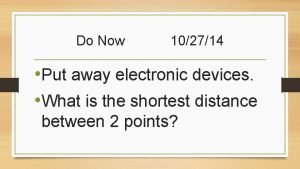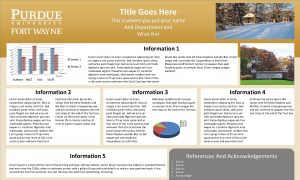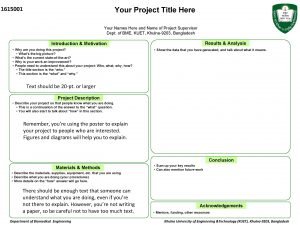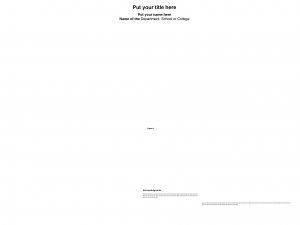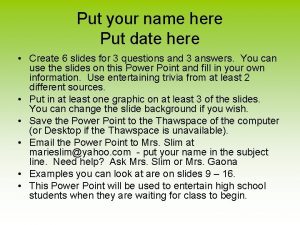Put Your Title here Your name 6 th












- Slides: 12

(Put Your Title here) Your name 6 th Grade Mrs. Latasha Harper Prince Edward County Middle School (Tape this slide to back of board)

Step #1: QUESTION (Type your question here. ) q Your question should be clearly asked and correctly punctuated with a question mark. q Your question should identify the independent and dependent variables. q Example: Is the temperature at which a saltwater solution boils higher than the temperature at which pure water boils? Independent variable (what changes): type of liquid Dependent Variable (what is being measured): temperature

Step 2: RESEARCH q Record the information from your research here. q Cite your sources: which website location, name of book with author, etc. q Remember…this information is what makes your hypothesis a SMART or EDUCATED guess!

Step #3: HYPOTHESIS q Your hypothesis should be an “If…, then…” statement that answers the Question in Step #1. q Your hypothesis should clearly identify the relationship between the independent and dependent variables. q Your hypothesis is an EDUCATED guess as to HOW the experiment will turn out. q Do NOT say “I think…”!

Variables q Independent variable: q Dependent variable: q Independent variable: The one variable that you change. q Dependent variable: This is what you are measuring; it is what happens when you change your independent variable.

Materials q. Materials should be listed and identified in detail with: o Specific amounts (using metric measures) o Type o Brand q. Include ALL tools used to measure your results, such as timer, graduated cylinder, etc.

Step #4: EXPERIMENT q All steps should be listed in correct order. q Measured items should be specific units, such as 32 m. L or 45 cm. q Variables should be easily identified. q Steps should be easily understood and repeated. q Multiple trials means more accurate data.

Step #5: ORGANIZE & ANALYZE DATA q To organize data in tables, use Word or Power Point. q To create graph, use Word or Power Point

Step #5: ORGANIZE & ANALYZE DATA q To organize data in tables, use Word or Power Point. q To create graph, use Word or Power Point.

Step #6: CONCLUSION q Type a brief summary here of what you discovered based on the results of your experiments. q You need to indicate whether or not the data supports the hypothesis and explain why or why not. q Conclusion should: o Clearly state what was learned as a result of your investigation o Whether results support or do not support your hypothesis o Identifies ways to improve the investigation next time o Includes possible ways to test differently next time.

Abstract (Type a brief overview or summary of your project here. ) q q Print out 1 extra copy to out to judges. Abstract is a summary of your project. Your project should be practical which means it has value and will help you in the future. Abstract is clearly stated and grammatically correct.

Project Title Step 1: Question Data Analysis Graph Step 4: Steps in Procedure Materials List Step 2: Research Step 3: Hypothesis Project Photographs Step 5: Data Analysis Data Collection. Table T 1 Independent & Dependent Variables T 2 T 3 T 4 Step 6: Conclusion Abstract T 5

